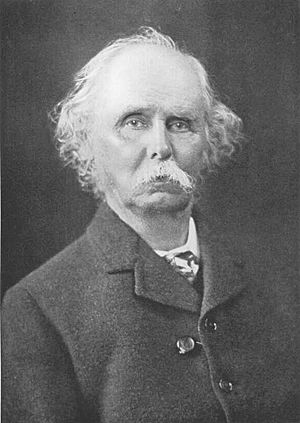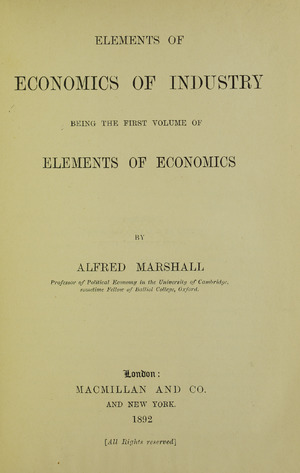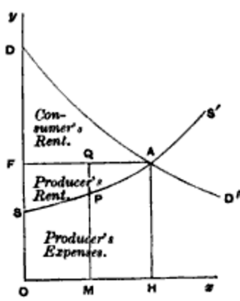Alfred Marshall facts for kids
Quick facts for kids
Alfred Marshall
|
|
|---|---|
 |
|
| Born | 26 July 1842 London, England
|
| Died | 13 July 1924 (aged 81) Cambridge, England
|
| Nationality | British |
| Institution | St John's College, Cambridge University College, Bristol Balliol College, Oxford |
| School or tradition |
Neoclassical economics |
| Alma mater | St John's College, Cambridge |
| Influences | Léon Walras, Vilfredo Pareto, Jules Dupuit, Stanley Jevons, Henry Sidgwick |
| Contributions | Founder of neoclassical economics Principles of Economics (1890) Marshallian scissors Internal and external economies |
Alfred Marshall (26 July 1842 – 13 July 1924) was an English economist. He was one of the most important thinkers in economics during his time. His famous book, Principles of Economics (1890), was the main textbook for economics in England for many years.
This book brought together important ideas like supply and demand, marginal utility (how much satisfaction you get from one more unit of something), and production costs. Marshall is known as one of the people who started neoclassical economics. This is a way of thinking about how people make choices and how markets work.
Contents
Who was Alfred Marshall?
Alfred Marshall was born in London, England. His father worked at a bank. Marshall went to Merchant Taylors' School and then to St John's College, Cambridge. He was very good at math there.
After college, Marshall had a difficult time. He decided to stop studying physics and started learning about philosophy. This led him to study ethics, which is about what is right and wrong. From ethics, he became interested in economics. He believed economics could help improve the lives of working-class people.
Marshall thought that improving people's living conditions was the main goal of economics. He also believed that these improvements would only happen if social and political forces worked together. He cared about topics like poverty, progress, and education for women. These interests came from his early ideas about society.
In 1865, Marshall became a teacher at St John's College, Cambridge. He taught moral sciences. Later, in 1885, he became a professor of political economy at Cambridge. He stayed there until he retired in 1908. He met many important British thinkers during his career. Marshall helped start the Cambridge School of economics. This group focused on how businesses grow and how to improve people's well-being.
What were Marshall's economic ideas?
Marshall wanted to make economics more scientific. He also wanted to use more math in it. In the 1870s, he wrote about international trade and protecting local industries. Many of these writings were put into a book called The Theory of Foreign Trade in 1879. In the same year, he published The Economics of Industry with his wife, Mary Paley.
Even though Marshall used a lot of math, he didn't want it to make economics too hard for everyday people. So, he wrote his books for everyone to understand. He put the complicated math parts in footnotes or at the end of the book for experts. He once said that economists should:
- Use math as a quick way to write down ideas.
- Keep using math until they finish their work.
- Then, explain it all in plain English.
- Show examples from real life.
- Finally, get rid of the math.
- If the examples don't work, get rid of the English explanation too!
Marshall married Mary Paley in 1877. Because of university rules at the time, he had to leave his teaching job at Cambridge. He then became the first leader of University College, Bristol. This college later became the University of Bristol. He continued to teach economics there. He improved his book Economics of Industry while in Bristol. This book became very popular in England. After William Jevons died in 1882, Marshall became the most important British economist of his time.
Marshall returned to Cambridge in 1884 to become a professor again. He worked hard to create a new degree program just for economics. He finally achieved this goal in 1903. Before that, economics was taught as part of history or moral sciences. Marshall wanted students who were very focused on economics.
Principles of Economics (1890)
Marshall started working on his most famous book, Principles of Economics, in 1881. He spent almost ten years writing it. He planned for it to be two volumes, covering all of economic thought. The first volume came out in 1890. It was praised around the world and made him one of the top economists. The second volume, which was supposed to cover topics like foreign trade and taxes, was never finished.
Principles of Economics made Marshall famous worldwide. It was printed in eight different versions, growing from 750 pages to 870 pages. This book greatly influenced how economics was taught in English-speaking countries. Some of its key ideas included:
- Elasticity: How much demand or supply changes when prices change.
- Consumer surplus: The extra benefit consumers get when they pay less than they were willing to.
- Increasing and diminishing returns: How much output changes when you add more inputs.
- Short and long terms: How different time periods affect economic decisions.
- Marginal utility: The extra satisfaction from one more unit of a good.
Many of these ideas were new from Marshall. Others were improved versions of ideas from other economists.
Marshall wanted to combine older and newer ideas about value. Earlier thinkers like John Stuart Mill thought value came from the effort put into making something. Later thinkers like William Stanley Jevons believed value came from how much people wanted something (utility). Marshall used both ideas, but he focused more on costs.
He explained that in the short term, supply can't change much, so market value mainly depends on demand. In a slightly longer time, businesses can make more goods using their current factories. But the costs of these factories (called fixed costs) don't change much. So, the main costs that affect the selling price are the variable costs, which change with how much is produced. In the very long term, factories and machines wear out and need to be replaced. So, the selling price must be high enough to cover these replacement costs. This way of looking at costs and time was a big contribution from Marshall.
Marshall's teaching and his Principles book were very successful because he used clear diagrams. Other teachers around the world quickly started using similar diagrams.
Alfred Marshall was the first to create the standard supply and demand graph. This graph shows how supply and demand curves work, where the market finds its balance (equilibrium), and how quantity and price are related. It also shows ideas like the law of marginal utility and the law of diminishing returns. This graph helps economists see complex ideas clearly. Before Marshall, these ideas were only explained with words.
Marshall's other ideas
Marshall is seen as one of the most important economists of his time. He shaped how economics was thought about for the next fifty years. He was also one of the founders of neoclassical economics. He built on the ideas of earlier economists like Adam Smith and David Ricardo. But he also changed economics from just focusing on markets to studying human behavior.
Marshall used utility analysis, but not to decide value. He used it to explain why demand curves look the way they do. His "scissors analysis" was very important. He said that demand (utility) and supply (cost of production) are like the two blades of a pair of scissors. Both are needed to cut, and both are needed to set a price. This idea shifted the focus from "value" to "price." Prices were no longer seen as fixed, but as a result of the relationship between demand and supply.
Marshall also made the use of supply and demand graphs popular for figuring out prices. He was a key part of the "marginalist revolution." This was the idea that consumers keep buying things until the extra satisfaction (marginal utility) from the last item equals its price. He also introduced the idea of price elasticity of demand, which measures how much demand changes when prices change.
He also contributed the idea of consumer surplus and producer surplus. Consumer surplus is the extra benefit buyers get, and producer surplus is the extra benefit sellers get. He used these ideas to study how taxes and price changes affect the overall well-being of a market.
Marshall also talked about "industrial districts." These were areas in England where many businesses making similar products were located close together. This closeness helped them share workers and information easily. These districts showed how competitive capitalism could be very efficient.
Gary Becker, a Nobel Prize winner in economics, said that Alfred Marshall was one of the two biggest influences on his work.
Another idea from Marshall was the difference between internal and external economies of scale. Internal economies of scale are when a single company becomes more efficient as it grows. External economies of scale happen when costs for all companies in a market go down. This might be because of better technology or cheaper materials that benefit everyone, not just one company.
Later life and legacy
Marshall had health problems that got worse over time. In 1908, he retired from Cambridge University. He hoped to finish the second volume of his Principles, but his health continued to decline. The start of World War I in 1914 made him look at the international economy again. In 1919, at age 77, he published Industry and Trade. This book was more about real-world facts than theories. In 1923, he published Money, Credit, and Commerce, which brought together many of his older ideas.
From 1890 until his death in 1924, Marshall was highly respected in the field of economics. He avoided arguments, which earned him great respect from other economists. Many important people visited his home in Cambridge. His students at Cambridge, like John Maynard Keynes, became leading figures in economics themselves.
Marshall's most important legacy was helping to create a respected, academic, and scientific profession for economists. He set the direction for the field for much of the 20th century.
Marshall died at age 81 at his home in Cambridge. He is buried in the Ascension Parish Burial Ground. The economics library at Cambridge University, the economics society there, and the economics department at the University of Bristol are all named after him. His old home, Balliol Croft, was renamed Marshall House in his honor in 1991.
His wife, Mary Paley, was one of the first women to study at Cambridge. She also taught at Newnham College. She lived in their home until she died in 1944.
Works
- 1879 – The Economics of Industry (with Mary Paley Marshall)
- 1879 – The Pure Theory of Foreign Trade: The Pure Theory of Domestic Values
- 1890 – Principles of Economics
- 1919 – Industry and Trade
- 1923 – Money, Credit and Commerce.
Images for kids
See also
 In Spanish: Alfred Marshall para niños
In Spanish: Alfred Marshall para niños




